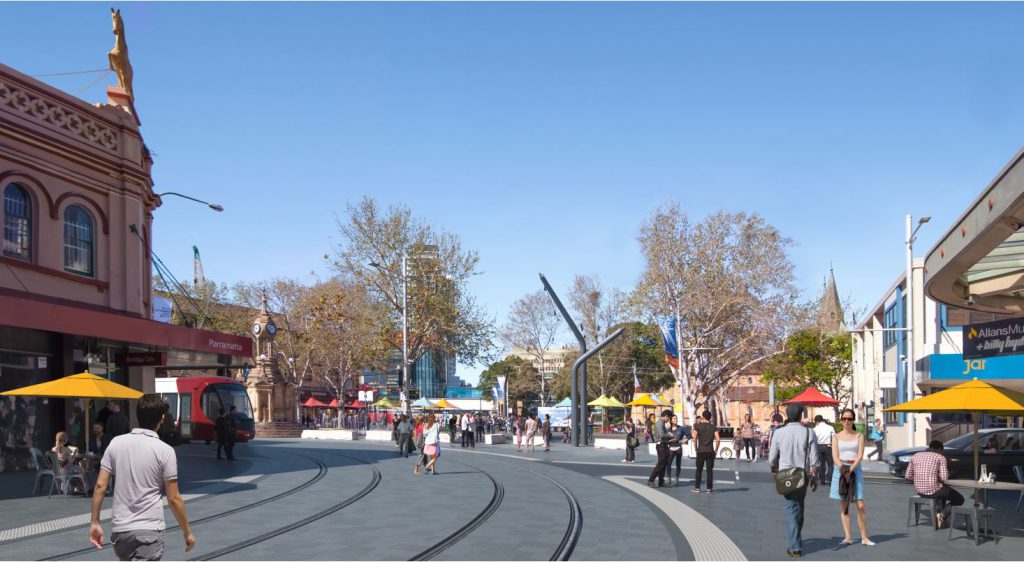Arup – 12d Innovation Awards 2018 – Overall Winning Entry
Arup Sydney’s entry in our Innovation Awards last year was truly fantastic. On the Parramatta Light Rail (Stage 1) project, they utilised 12d Model in innovative ways, bringing in all manner of applications not often seen before. The project worked on lots of different areas around Parramatta, requiring a lot of different solutions, and involved not just the design/construction of the light rail itself, but the enabling works that allowed the light rail to be built. In one section, they even needed to change a one-way street into a two-way street. It was a complex, multi-disciplinary project, and finding the right collaborative solution was essential. They spent time at the outset working this out, to great benefit.

We caught up with designers Jarred Dickson and Danny Wilcox to chat about their entry, which they submitted “to showcase the innovative things [they] were doing on the project,” and how this innovation helped the project.
To their team, ‘innovation’ meant ”doing something different”, “pushing the boundaries”, and finding new ways to do things. They did a lot of design verification checks – turning paths, sightline checks, etc. – in 12d Model (rather than externally as is usually the practice); this meant these aspects of the project could be in 3D rather than 2D as was previously the norm, and these could be reviewed as people were working on the design, rather than having to do this only at the end and having to go back and do rework. One of their favourite things about this was that 12d Model acted as a collaborative tool among all the different disciplines – it was the one true source model.
‘Digital Engineering’, to Arup, means doing everything digitally in one place. In the past, only half the design was in 3D and the rest was in 2D. On this project they only needed one drafter, and even she was working with them inside 12d Model. This meant not having to do much on paper at all. Collaboration meant everyone was working with the same tools, live. Not only did this benefit the team, the client (Transport for NSW) saw the benefits and was very pleased with the results. The team at Arup is confident that the time they spent setting this up will mean greatly improved efficiency across their future projects.
Danny told us that their previous workflow ‘would make a mess of a whiteboard’ – going back and forth between CAD and 12d Model, and with other disciplines (road design, structures, landscaping, urban design, etc.)…the old processes were very manual, very much on paper, and full of reviews and redesigns. Having it all in the model alleviated this, and the review process was so much easier – it could be done along the way, in 12d Model, visible in one 3D space. They thought there might be some resistance to this process being wholly digital, but actually the client was thrilled when they saw how much more efficient it was.
4D, 5D, and even 6D BIM came into this project. One section of roadworks had a very complex structure for a road widening, and they were able to create a full 4D design of how this road could remain open while the construction occurred, to minimise disruption in a busy area. Being able to increase efficiency (and reduce errors) in this regard allowed the teams to save a lot of money on this project. Future projects will also be more efficient through following the methods devised on this one.
MTFs, Snippets, and macros were some of the 12d Model tools that assisted these processes. Smart Snippets automated and streamlined the design process by enforcing the way things were modelled for consistency across the project. Danny mentioned that “the way 12d is set up to allow you to customise in-built panels with macros is pretty cool.” He said this project allowed them to take this kind of thing ‘to the next level’. The team also benefited from using Chains, because this gave them a way to describe new tools to others, and lay down how things work (including naming conventions) so the whole team can be ‘on the same page’. They can now bring these Chains into any project.
Vehicle Paths and Sight Lines computated within 12d Model have also been a new development – they used to be done in CAD, and this new method revolutionised processes. Trees, signage and more could be included in the 3D model. A register within 12d Model made this much easier to manage. For those who have trouble imagining 2D plans in 3D, this was incredibly helpful. Different ways to present utilities were devised, and these will be applied on many other projects over time.
The plan moving forward is to share these lessons and skills with others in the company – the small team involved in this project will be sharing ideas through the rest of Arup on Design Verification, Smart Snippets, and more.
This innovative work has set the standard for others to follow in future projects – this team has really ‘set the bar’, not just within Arup, but for the industry as a whole.